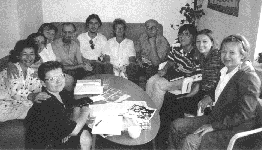|
|

|
 |
|
|
|
Quakers in Eastern Slavonia by Mary Arnett In June 1997, Dorothy Carroll and I, of Philadelphia Yearly Meeting, visited Croatia. In Eastern Slavonia, at the Baranja International Meeting House and the Osijek Peace Center, we found many ways Friends in our Yearly Meeting and in Yearly Meetings all over North America can be supportive through AVP, mediation, "Links", and the 5-person peace teams for villages. A description of these initiatives follows. A sympathetic government official told us that he would know where to place a thousand such teams throughout Croatia and the neighboring countries. Osijek Osijek is the largest city in Eastern Slavonia. It is in the midst of the problems caused by the displacement of Serbs by Croats and the resulting displacement of Croats by Serbs and in the midst of the fear and despair these two peoples feel in relation to one another. Osijek is also in the midst of, rather than on the outskirts of, the delay and inflexibility of the central government. At the same time it is home to a growing number of concerned citizens who are resolved to take matters into their own hands and find peaceful ways to solve their problems. In 1993, having experienced the bombing of Osijek, a young physician, Katarina Kruhonja, came to the realization that killing was never justified. Grounded in deep religious belief, she and a colleague, grounded in Gandhian secularism, resolved to put their deep commitment to peace into action. As Sr. Mary Evelyn Jegen details in a moving tribute, entitled "Sign of Hope" (Uppsala, Life and Peace Institute, 1996), they first linked up with the Anti-War Campaign in Zagreb, a loosely knit group of people working to end the war. A member of the Anti-War Campaign took the news of the peace effort in Osijek to an international meeting of the Helsinki Citizens' Assembly (HCA) in Bratislava. While attending the HCA, British Friend Adam Curle of Quaker Peace and Service was so impressed with what he heard about this peace effort that he and a small delegation of Friends soon arrived in Osijek, which was still under shelling. The visitors were all invited to give workshops on the theme "Peace Mediation and Creative Solving of Conflicts." Adam Curle emphasized the importance of the role of one individual. The movement in Osijek began to grow and formed into a group, independent of, but affiliated with the Anti-War Campaign, calling itself the Center for Peace, Nonviolence, and Human Rights. They became registered as a non-governmental organization. Adam Curle and other British Friends continued to work closely with them. Quaker experience was also drawn upon as they made self-education a basic component of their growth.
In 1993, British Friend Rosemary Street, qualified as a psycho-social trainer, came to the Osijek Peace Center. Rosemary had been through a course on nonviolent communication at Woodbroke College, worked in Singapore, and now inquired at the Center whether she could be of any help. She stayed for six months, assisting with many facets of its work. Beli Manastir In January 1994, Rosemary Street returned to Eastern Slavonia with her husband, Nicholas, a qualified manager, both making a five-year commitment to the area. For most of 1994, they worked in Osijek with the Peace Center; they then worked for about a year with community groups across the Danube in Vojvodina, Serbia. Accepting an invitation to live in a house in Beli Manastir, the largest town in Baranja, as the area in the north of Eastern Slavonia is called, they took up residence about an hour's drive north of Osijek. There they have been living under a concern to be a helpful third-party nonviolent presence, to listen to the concerns of the local people, and to help in whatever ways they are asked. Their work compliments and extends that of the Peace Center in Osijek, of which they are members. They are engaged in facilitating workshops in a "neutral" place which brings Croats and Serbs together in a variety of activities, in accompanying members of each group when they must traverse the territory of the other, and in teaching English. They foresee the need to increase activities and staff in the year ahead and are proposing to turn their residence into the Baranja International Meeting House (BIMH). Some new directions they see for their work are:
BIMH is also supporting the Osijek Peace Center in a massive effort to provide help for the 55,000 or so displaced persons who left the UNTAES zone in 1991 and have been living in the Osijek area ever since. They are now a very angry and negative group. The Osijek Peace Center is setting up twenty teams of five people (four locals and one international per team) to go and live in the villages in the area. Their work will be to find ways, practical and inter-personal, to ease the path of these displaced persons back into their homes, many of which have been destroyed and will need to be rebuilt, and to try to recreate local communities which have been shattered. This work is so far being funded by the Swedish Life and Peace Institute, which also provides training. For more information go to: Eastern Slavonia on the Brink of War TOP
• CURRENT Issue Index • PTN
Index • HOME |
||
